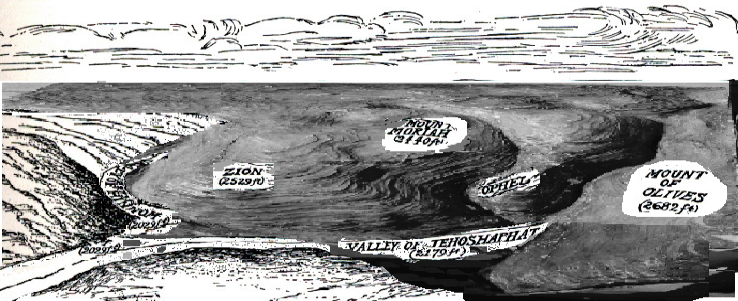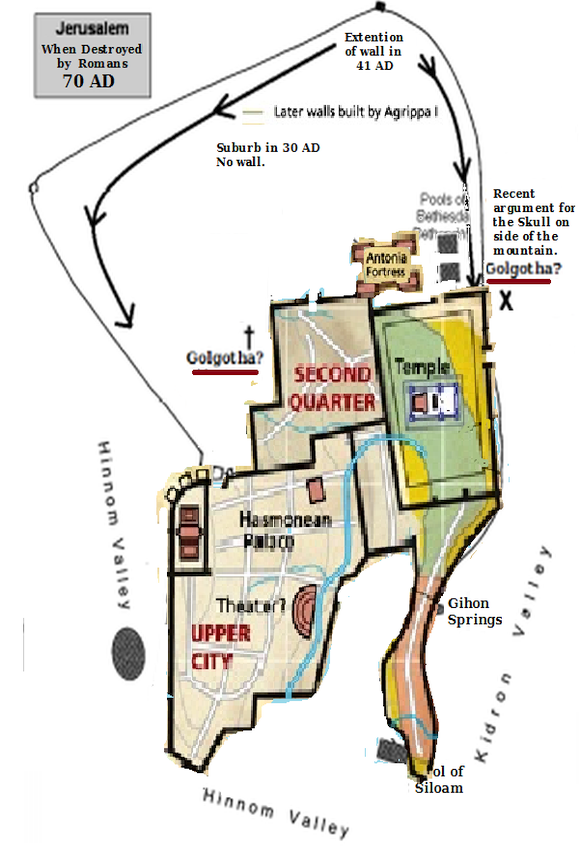|
FREQUENTLY ASKED QUESTIONS FREQUENTLY ASKED QUESTIONS
|
Question.
CAN LUKE 13:33,34 AND HEBREWS 13:12,13 BE HARMONIZED?
Q. How can these scriptures be harmonized?
Luke 13:33-34 “Nevertheless I must go on my way to-day and to-morrow and the day following: for it cannot be that a prophet perish out of Jerusalem. O Jerusalem, Jerusalem, the one who kills the prophets and stones those who are sent to her!”
Hebrews 13:12-13 “Therefore Jesus also, that He might sanctify the people with His own blood, suffered outside the gate. Therefore let us go forth to Him, outside the camp, bearing His reproach.”
Gaylon's answer.
Is Luke 13:33-34 a generalization? Verse 33b, "for it cannot be that a prophet perish out of Jerusalem", seems to be a generalized statement since, for example, the prophet John did not perish in Jerusalem. The Bible suggestss that he was beheaded in Galilee. According to the Jewish historian Josephus, John was beheaded at Herod the Great’s palace-fortress of Machaerus on the east side of the Dead Sea in modern Jordan ( Antiquities 18.5,2).
But like you, I understand Jesus to make a prophetic vision of His death and that it was to be in Jerusalem. Vincent explains that the verb means to accept or admit; so that the sense is, “it is not admissible that.” He adds the comment, "The expression is ironical and hyperbolical, with reference to Jerusalem as having a monopoly of such martyrdoms." A.T. Robertson agrees. The adverb "out of" if from the word "ex" (e.g., exit); Strong's: "out (side, of doors), literally or figuratively: - away, forth, (with-) out (of, -ward), strange." So, the meaning is that Jesus was talking about not being "away from" Jerusalem.
Now the geography for Jesus' death was in the environs of the city of Jerusalem. A few Jerusalem inhabitants had their homes there. In just a few years the current Herod added a north wall on the city's mountain which would hold back the Romans for about a half year in their siege thirty years later. So Jesus died in the environs of the city of Jerusalem but outside of the existing wall ("gate") as Hebrews 13 records.
If we consider Golgotha #2 on the northeast side of the city, the mound would be on the side of the mountain as it falls into the ravine. Such a location surely would be considered a part of the city.
GEOGRAPHY AND HISTORY OF FIRST CENTURY JERUSALEM
Jerusalem had about 15 acres in David’s time. That was the area of the Canaanite city (of the Jebusites). But when David added the Temple hill (Mt. Moriah) and all the adjacent area, we jump to 37 acres (the tenth century BC). By the eighth century BC we are talking about a site of 150 acres. We now know from the work of Gaby Barkay and others, the northern area was settled too, although it was not fortified with a wall. So you have to add a lot of suburbia around iti which would make the area definitely part of the city. It is as Hebrews points out, outside of the gate.
Jerusalem



Before the Six-Day War. When I visited Jerusalem in 1959 while in the US Navy, I was surprised not to see the “three” major mountains as taught in my geography class. The terrain rather rolls over one mound or hill after the other. Jerusalem can be said to rest upon four/five hills or “mountains” as they are named, but only two of them are prominent: Mount Zion and Mount Moriah. Mount Olivet is actually not one of the hills of Jerusalem although it immediately joins to the east of the ancient city. Between these mountains there is a valley that the Romans called the Tyropoean Valley. Actually, Mount Zion was referred to geographically as the southwestern mound of Jerusalem between the Tyropoeon and Hinnom valleys. This spot was called the Upper City and was apparently where the wealthy lived during the time of Jesus.ii Zion has much greater significance in the Bible because it is frequently mentioned as the place of the Temple and of the King. When David said that he would not rest until he "has found out a place for the Lord, a habitation for the mighty God of Jacob," the Lord replied with this Scripture:
Zion Is A Collective Name. “For the LORD has chosen Zion; He has desired it for His dwelling place: This is My resting place forever; Here I will dwell, for I have desired it” (Psalms 132:13-14). So we know from this that the name Zion can include Moriah and Ophel hills because the temple was definitely placed on the Moriah’s section and is where the Muslim Dome is today. If Zion can refer to the whole area, can not Jerusalem refer to the entire environs?
The rugged terrain of Jerusalem was a definite military advantage, it was easy to defend because the city can only be reached militarily on its northern side. The east, west, and southern sides have steep ravines or valleys.iii
In 41 AD Herod Agrippa II extended the city walls to the north to include the residential quarter of the growing city. It was during the years 41-44 AD that the traditional site of Jesus’ crucifixion and burial were surrounded with walls and brought within city limits. If this area was important to the city, could not Jerusalem include it? Note: the traditional “Golgotha” and burial was “identified” by Emperor Constantine’s mother.
Herod Agrippa walled in the northern suburb a few years after Jesus was crucified. So if the traditional is the real Golgotha then Jesus was crucified and buried in the northern suburbs of Jerusalem.
The Jews began a revolt against the Roman Empire in 66 AD by retaking Jerusalem, but this resulted in the Roman siege of Jerusalem beginning in April of 70 AD. It ended with the burning of the Temple on August 10, 70 AD. The Tenth Roman Legion (Legio X Fretensis, in Latin) was stationed in Jerusalem for the next 200 years, occupying the western side of the city and the citadel. It is clear the Temple treasures followed Titus and his legions back to Rome in 70 AD attested by the still-standing Arch of Titus in Rome.
It is interesting that Christians are said to have fled Jerusalem in 66 AD when they saw the approaching Roman armies (as advised by Jesus in Luke 21:20-22) but began returning to Jerusalem in 73 AD.
Other references of interest:
http://www.generationword.com/jerusalem101/1-biblical-jerusalem.html
-Gaylon
i https://zionismandisrael.wordpress.com/2008/07/01/the-size-of-ancient-jerusalem/
ii http://www.bible-history.com/jerusalem/firstcenturyjerusalem_the_land_of_jerusalem.html
iiiIbid.
